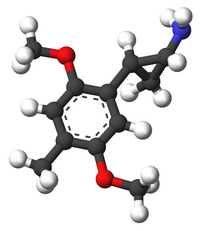Chemistry:2,5-Dimethoxy-4-methylphenylcyclopropylamine
From HandWiki

| |

| |
| Names | |
|---|---|
| Preferred IUPAC name
2-(2,5-Dimethoxy-4-methylphenyl)cyclopropan-1-amine | |
| Identifiers | |
| |
3D model (JSmol)
|
|
| ChEMBL | |
| ChemSpider |
|
PubChem CID
|
|
| UNII | |
| |
| |
| Properties | |
| C12H17NO2 | |
| Molar mass | 207.273 g·mol−1 |
Except where otherwise noted, data are given for materials in their standard state (at 25 °C [77 °F], 100 kPa). | |
| Infobox references | |
Tracking categories (test):
2,5-Dimethoxy-4-methylphenylcyclopropylamine (DMCPA) is a lesser-known psychedelic drug and a substituted amphetamine. DMCPA was first synthesized by Alexander Shulgin. In his book PiHKAL, the dosage range is listed as 15–20 mg and the duration is listed as 4–8 hours.[1] DMCPA produces open-eye visuals, anorexia, and psychedelic dreams. Shulgin gives it a +++ on the Shulgin Rating Scale.
Legality
United Kingdom
This substance is a Class A drug in the Drugs controlled by the UK Misuse of Drugs Act.[2]
Pharmacology
Very little data exists about the pharmacological properties, metabolism, and toxicity of DMCPA.
See also
- Phenethylamine
- Psychedelics, dissociatives and deliriants
- Tranylcypromine
References
| Phenethylamines |
|
|---|---|
| Amphetamines |
|
| Phentermines |
|
| Cathinones |
|
| Phenylisobutylamines | |
| Phenylalkylpyrrolidines | |
| Catecholamines (and close relatives) |
|
| Miscellaneous |
|
 | 0.00      (0 votes) (0 votes) |
